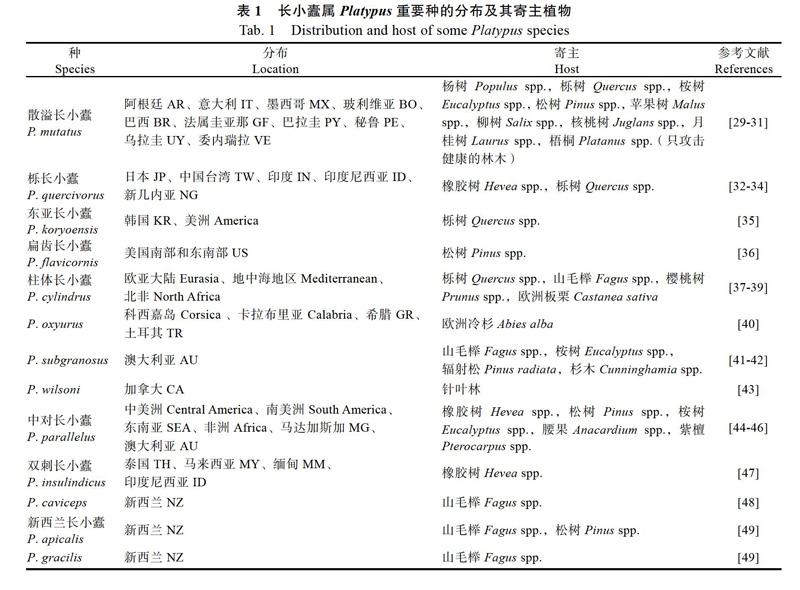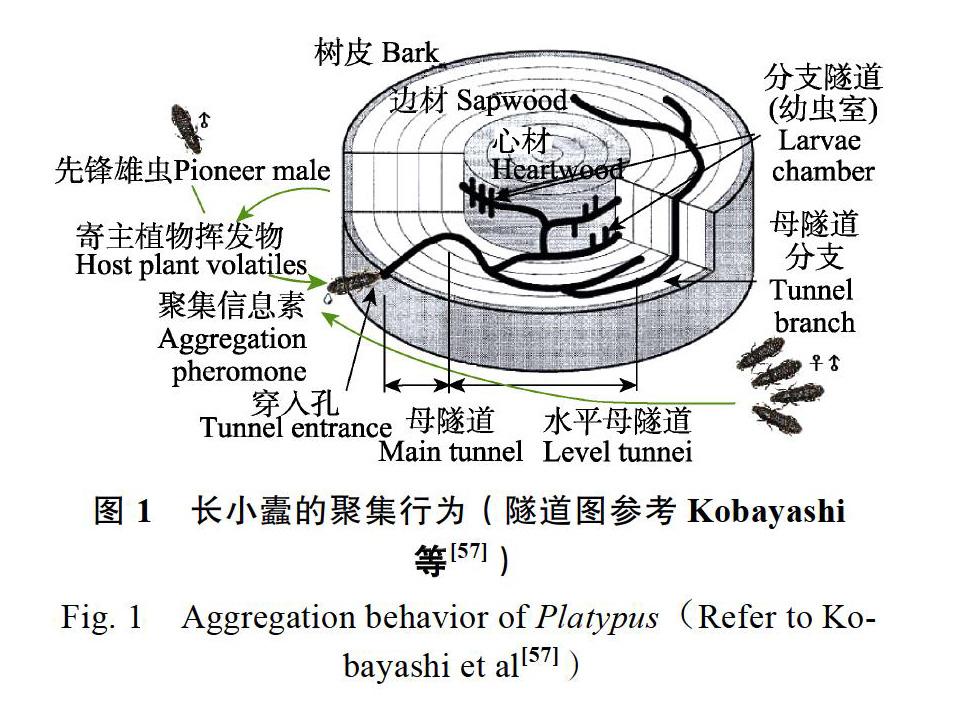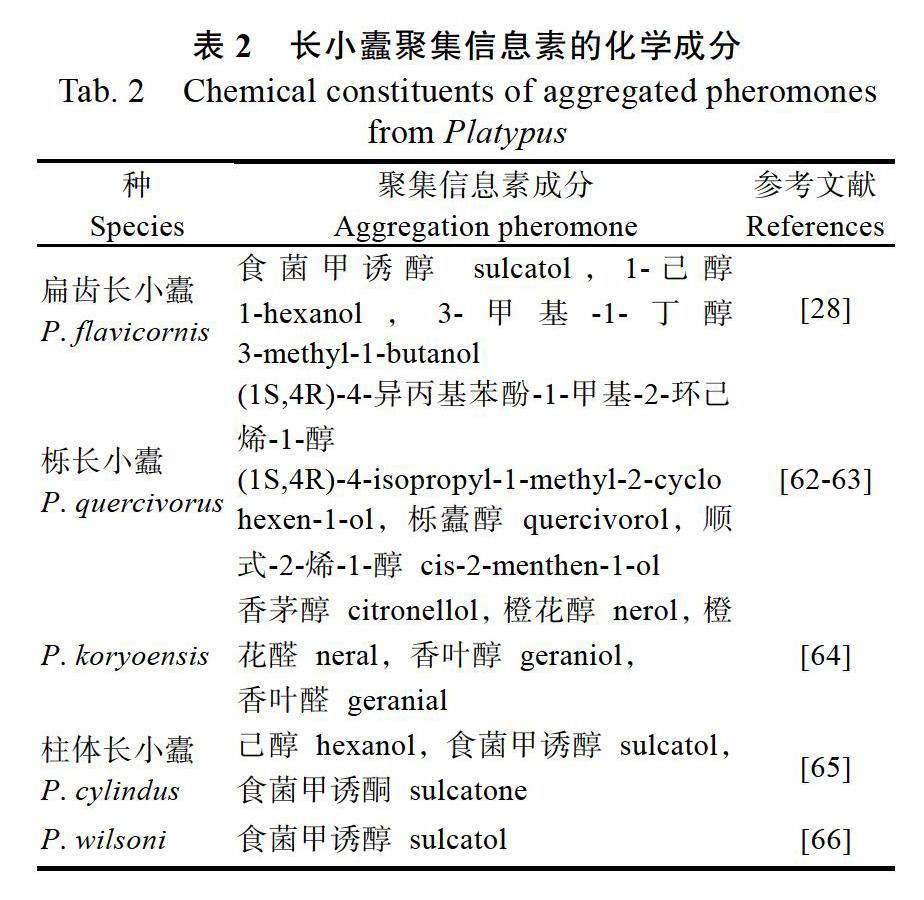长小蠹聚集信息素研究概况
2019-06-11雷高科符悦冠吴伟坚
雷高科 符悦冠 吴伟坚



摘 要 长小蠹属(Platypus)昆虫是危害森林生态系统的重要类群,严重时可造成林木大面积枯死。聚集信息素可用来监测长小蠹的种群密度,进行大规模诱捕和中断交配行为。本文从长小蠹属昆虫的聚集行为,聚集信息素的产生和释放,聚集信息素的化学组成以及应用等方面综述了长小蠹聚集信息素的研究概况。
关键词 长小蠹;聚集行为;聚集信息素中图分类号 S763.7 文献标识码 A
长小蠹科(Platypodidae)属鞘翅目(Coleoptera)、多食亚目(Polyphaga)、象虫总科(Curculionoidea),是危害森林生态系统的重要昆虫类群[1],名字来源于在钻蛀隧道时携带的真菌孢子(ambrosia)[2]。全世界发现的长小蠹种类超过1400种[3],主要分布在热带、亚热带和接近亚热带的温带区域[4],以赤道为中心,北达英国、朝鲜和美国的犹他州,南至津巴布韦、澳大利亚和阿根廷。主要危害衰弱或遭砍伐的林木[5],可造成林木大面积枯死。
长小蠹属(Platypus)是长小蠹科的重要类群,一般危害直径大于20 cm的林木树干[6]。长小蠹在寄主林木的木质部钻蛀隧道并产卵[7],削弱树干的承受能力,使其在极端环境下极易折断[8],腐烂的真菌孢子也可使林木出现深色斑而降低木材的质量[5]。由于长小蠹具有个体小、生活隐蔽、繁殖迅速等特性,防治非常困难[9],为减少长小蠹属昆虫对林木的危害,有必要对其进行监测[10],以便及早进行防控。
昆虫信息素是由昆虫分泌并释放到体外引起同种其他个体产生行为反应的化学物质,主要包括性信息素、聚集信息素、追迹信息素、告警信息素和产卵信息素等[11-12]。昆虫信息素在昆蟲的产卵、追踪、防御、定向、召唤、交尾、聚集、告警以及种间识别等行为都具有重要的作用[13]。合成昆虫信息素是害虫治理的有力工具,经常被用来监测种群密度,进行大规模诱捕和中断交配行为等[14]。
昆虫聚集信息素(aggregation pheromone)是由雌雄任一性别的昆虫产生并能引起雌雄两性同种昆虫聚集行为反应的化学物质[15]。聚集信息素在昆虫获得有益的环境、交配、获取食物和抵御外敌的侵袭上发挥作用[16-17]。昆虫聚集信息素主要应用于虫情监测和害虫诱杀等方面。
1966年研究人员第一次从加州十齿小蠹(Ips confusus)雄虫中鉴定出信息素[18],之后更多小蠹虫信息素被发现,多数为单萜类化合物或其衍生物[19-24],并且大小蠹属(Dendroctonus)和齿小蠹属(Ips)信息素的合成部位、合成途径均已被研究发现[25-27]。1977年Renwick等[28]首次发现扁齿长小蠹(Platypu flavicornis)存在聚集信息素,此后,更多学者对多种长小蠹的聚集行为、聚集信息素的产生和释放、聚集信息素的化学组成及其应用等方面进行了研究。本文对这些研究进行了综述,以期为小蠹聚集信息素在长小蠹综合管理上的合理应用奠定基础。
1 长小蠹属Platypus重要种的分布及其为害的寄主植物
现记录的长小蠹属昆虫超过120种[3],分布范围广,尤以热带和亚热带种类多,寄主范围也很广。主要危害松树、栎树、橡胶树等针叶林和阔叶林,为多食性昆虫。表1为几种重要长小蠹属昆虫的分布及为害情况。
2 长小蠹聚集行为
长小蠹的入侵一般发生在早上,黎明后不久,当温度升至13 ℃以上[50],寄主林木散发的气味(主要是乙醇和单萜类)会吸引长小蠹雄虫侵入[48]。先锋雄虫落于树上,利用现有的小蠹虫钻蛀孔或树木伤口孔,在几个小时内钻蛀出1条直径约1.5 mm、深度10 mm的初始隧道[51]。在开始钻蛀隧道2 d后,雄虫出现在隧道口,一滴液体从后肠排出[52],液体中包含聚集信息素[53]。雄虫再次向隧道内移动并弯曲腹部,将完全成型的液滴滴在紧邻隧道入口的树皮表面上。有时雄虫不会移至隧道口,而是将液滴擦于隧道壁上[52](图1)。雌雄成虫的吸引需要3~10 d,在此期间,未交配的雄虫大部分时间都将腹部暴露在隧道入口处[50]。聚集信息素吸引的雄虫寻找新的位置钻蛀初始隧道。吸引的雌虫一旦找到占据隧道且未交配的雄虫,则会会进入该隧道,将额部压于雄虫的腹部并发出“嗡嗡”的声音,此时雄虫则会倒退出隧道,让发声的雌虫进入。在隧道里待一段时间后,雌虫又回到树表皮面,只把头和前足留在隧道内,雌雄随即开始交配[54]。当长小蠹在隧道入口外交配时,摩擦声随即停止。交配完成后,雄虫随雌虫回到隧道[49]。小蠹科的小蠹虫在一个或几个配偶进入隧道后释放抗聚集信息素。目前尚未有关于长小蠹交配后发生化学信号变化的研究[55]。Ueda等[56]认为交配后P. quercivoru的聚集行为消失了,因为交配雄虫入侵的树干比未交配雄虫入侵树干吸引的P. quercivoru少。然而,他们无法证实这一假设,2种树干吸引到的P. quercivoru数量差别很小,长小蠹交配后聚集行为的消失需要进一步的研究。
交配完成后雌虫继续钻蛀穿入孔,完成水平母隧道的修筑。穿入孔和母隧道的总长达到13~15 cm,成虫钻蛀最初这段隧道的速度约为1 cm/(10~20) d[51]。随后,雌虫从水平母隧道钻蛀出4条左右分支母隧道。雌虫在修筑隧道的同时,所携带的真菌孢子在隧道壁萌发出菌丝,作为下一代幼虫和成虫的营养来源,并在各处产卵[58]。孵化的幼虫在食用菌丝达到5龄后[59],会从分支母隧道的垂直方向,钻蛀出长1 cm左右的蛹室,在蛹室内化蛹,以蛹形态越冬。春天,蛹室的蛹羽化成新成虫,在隧道倒转,从穿入孔离开寄主[57]。
雄虫则通过堵塞洞口来保护隧道免受天敌和杂菌的侵入,还可以阻止其他雄虫进入,并避免幼虫掉出隧道。雄虫会调节孔洞的湿度,保持孔道的高湿度,促进真菌孢子生长[60]。雄虫的腹部上下移动,进行换气[57],并把由雌虫及其后代产生的碎屑全部排出[54]。长小蠹是“一夫一妻制”,亲代雌雄成虫会一直留在隧道中,直到死亡,雄虫有时暂时从隧道出来,让下一代成虫离开[51]。
3 長小蠹聚集信息素的化学成分
Ueda[52]发现新西兰长小蠹(P. apicalis)产生的含聚集信息素的液滴通常是不透明的白色,但有时也会是透明的,也有黄色或棕色,新产生的液滴具有独特的柠檬气味。液滴大小不同,最大直径约为0.5 mm,但通常只有0.25 mm。对长小蠹聚集信息素的分离鉴定研究表明,长小蠹聚集信息素的化学成分主要是烯醇类[61],目前已发现5种长小蠹的聚集信息素(表2)。
4 长小蠹聚集信息素的应用
昆虫聚集信息素在害虫防治中起到重要的作用,目前已成功应用于种群监测和大量诱杀中。虽然对长小蠹的聚集信息素的研究较少,但利用聚集信息素进行虫情监测和害虫诱杀已有一些成功的案例。日本每年由P. quercivorus引起的落叶栎枯死现象十分普遍,为了预测P. quercivorus的发生动态,利用聚集信息素(1S,4R)-4-isopropyl- 1-methyl-2-cyclohexen-1-ol作为诱剂对P. quercivorus的种群动态进行监测[62]。江苏省出入境检验检疫局利用树木引诱成分和小蠹虫聚集信息素有效成分配制出的引诱剂,张家港出入境检验检疫局从东南亚、非洲、大洋洲和俄罗斯进口的木材上诱捕到包括长小蠹在内的多种昆虫[67]。
P. quercivorus是日本栎枯萎病病原Raffaelea quercivora的传播媒介,曾造成日本栎大面积枯萎,P. quercivorus聚集信息素能够诱捕比空白对照多14.4倍的成虫,可用于长小蠹的防治[14]。P. koryoensis是韩国柞树枯萎病的媒介,造成柞树(主要是蒙古栎Quercus mongolica)大量死亡,用P. koryoensis的聚集信息素对其进行诱杀有较好的控制作用[64]。Kim等[68]也试验出乙醇与橙花醛的混合物(95∶5,V/V)对P. koryoensis具有最好的诱捕效果。P. cylindrus是地中海地区栓皮栎Quercus variabilis真菌病的媒介,Henriques等[65]曾利用聚集信息素(己醇、食菌甲诱醇和食菌甲诱酮的混合物)添加寄主植物挥发物(a-侧柏酮、莰烯和b-蒎烯)进行了诱杀试验。
5 展望
聚集信息素具有生物活性高、特异性强、使用简单、不污染环境、持久性长、对人畜无毒害、不影响天敌、分解较快等特性[69-70],在使用过程中,不仅能够防治害虫,还可以减少化学农药大量使用造成的环境污染,达到控制害虫的目的,从而维护生态系统的平衡,促进林业可持续发展[71]。
长小蠹聚集信息素的鉴定和应用方面的研究已经取得一些成效,但还有很多问题没有得到解决。今后长小蠹聚集信息素的研究一方面随着分析设备的进步和试验方法的完善,更易对微量组分进行成分鉴定和功能研究,可将各个长小蠹聚集信息素化学成分补充完整;另一方面对作用机制的研究也应加以重视,长小蠹主要通过嗅觉对聚集信息素进行识别,完善对长小蠹嗅觉系统的研究可以更好的防治长小蠹。聚集信息素在害虫监测、大量诱杀、检验检疫等方面的应用需要进行更广泛的理论研究,并进行大量的林间试验,扩大聚集信息素的应用;另外尽管有些聚集信息素已经生产使用,但仍面临成本高的问题,今后的研究可以考虑将聚集信息素和不同寄主挥发物结合使用,降低成本,提高效率。随着长小蠹聚集信息素研究的不断深入,可以更有效的防治长小蠹,保护森林生态平衡。
参考文献
[1] 周 萍. 基于信息化学物质的检疫性小蠹与长小蠹引诱剂的研发与应用[D]. 泰安: 山东农业大学, 2016.
[2] Gonzalez Audino P, Griffo R, Gatti P, et al. Pheromone detection of the introduced forest pest Megaplatypus mutatus (=Platypus mutatus) (Chapuis) (Platypodinae, Curculionidae) in Italy[J]. Agroforest Systems, 2013, 87(1): 109-115.
[3] Wood S L. Revision of the genera of Platypodidae (Coleoptera)[J]. The Great Basin Naturalist, 1993, 53(3): 259-281.
[4] 陈乃中. 长小蠢科与检疫[J]. 植物检疫, 1990, 4(2): 107-114.
[5] Gonzalez Audino P, Villaverde R, Alfaro R, et al. Identification of volatile emissions from Platypus mutatus (=sulcatus) (Coleoptera: Platypodidae) and their behavioral activity[J]. Journal of Economic Entomology, 2005, 98(5): 1506-1509.
[6] Lucia A,Gonzalez Audino P,Masuh H. Volatile organic compounds from the clone populus x canadensis “Conti”associated with Megaplatypus mutatus attack[J]. Psyche, 2014,2014: 793298.
[7] Lee J S, Haack R A, Choi W I. Attack pattern of Platypus koryoensis (Coleoptera: Curculionidae: Platypodinae) in relation to crown dieback of Mongolian Oak in Korea[J]. Environmental Entomology, 2011, 40(6): 1363-1369.
[8] Ceriani-Nakamurakare E, Slodowicz M, Carmaran C, et al. Development of natural waxes dispensers for pheromones and use in mating disruption of the ambrosia beetle Megaplatypus mutatus in poplar (Populus spp.) plantations[J]. Agroforestry Systems, 2017, 91(3): 415-421.
[9] 王玉洁, 赵冬香, 曹海鹏. 小蠹虫信息素的研究与应用现状[J]. 华东昆虫学报, 2007, 16(4): 299-303.
[10] Milligan R H, Osborne G O, Ytsma G. Evidence for an aggregation pheromone in Platypus gracilis Broun (Col., Platypodidae)[J]. Journal of Applied Entomology, 1988, 106: 20-24.
[11] 韩宝瑜. 昆虫化学信息物质及其在害虫治理中的应用展望[J]. 安徽农学通报, 2002, 8(1): 12-13.
[12] 迟克强, 孙亚飞, 孙守慧, 等. 昆虫化学信息物质概述[J]. 吉林林业科技, 2004, 33(5): 27-30.
[13] 姜 勇, 雷朝亮, 张钟宁. 昆虫聚集信息素[J]. 昆虫学报, 2002, 45(6): 822-832.
[14] Kamata N, Esaki K, Mori K, et al. Field trap test for bioassay of synthetic (1S, 4R)-4-isopropyl-1-methyl-2-cyclohexen- 1-ol as an aggregation pheromone of Platypus quercivorus (Coleoptera: Platipodidae)[J]. Journal of Forest Research, 2008, 13(2): 122-126.
[15] 高长启, 孙守慧, 宋福强, 等. 昆虫信息素及其在害虫防治中的应用[J]. 吉林林业科技, 2001, 30(1): 1-4.
[16] 冯化成. 昆虫的集合信息素[J]. 农药译丛, 1994, 16(5): 7-14.
[17] 赵博光, 张松山. 国外昆虫聚集信息素研究概况[J]. 南京林业大学学报, 1993, 17(1): 84-90.
[18] Silverstein R M, Rodin J O, Wood D L. Sex attractants in frass produced by male Ips confusus in ponderosa pine[J]. Science, 1966, 154(3748): 509-510.
[19] 程 彬, 张 健, 侯丽伟. 云杉八齿小蠹信息素的研究進展[J]. 环境昆虫学报, 2018, 40(2): 268-275.
[20] Tittiger C, Blomquist G J. Pheromone biosynthesis in bark beetles[J]. Insect Science, 2017, 24: 68-74.
[21] Zhao T, Axelsson K, Krokene P, et al. Fungal symbionts of the spruce bark beetle synthesize the beetle aggregation pheromone 2-Methyl-3-buten-2-ol[J]. Journal of Chemical Ecology, 2015, 41(9): 848-852.
[22] 赵玉民, 王艳军, 陈国发, 等. 小蠹聚集信息素研究与应用的进展[J]. 内蒙古林业科技, 2011, 37(3): 55-60.
[23] Cuthbert R A, Peacock J W. Response of the elm bark beetle, Scolytus multistriatus (Coleoptera: Scolytidae), to component mixtures and doses of the pheromone, multilure[J]. Journal of Chemical Ecology, 1978, 4(3): 363-373.
[24] Hughes P R, Renwick J A A, Vite J P. The identification and field bioassay of chemical attractants in the roundheaded pine beetle[J]. Environmental Entomology, 1976, 5(6): 1165-1168.
[25] Blomquist G J, Figueroa-Teran R, Aw M, et al. Pheromone production in bark beetles[J]. Insect Biochemistry and Molecular Biology, 2010, 40(10): 699-712.
[26] Hendry L B, Piatek B, Browne L E, et al. In vivo conversion of a labelled host plant chemical to pheromones of the bark beetle Ips paraconfusus[J]. Nature, 1980, 284(5755): 485.
[27] Vité J P, Ohloff G, Billings R F. Pheromonal chirality and integrity of aggregation response in southern species of the bark beetle Ips sp.[J]. Nature, 1978, 272(5656): 817-818.
[28] Renwick J A A, Vité J P, Billings R F. Aggregation pheromones in the ambrosia beetle Platypus flavicornis[J]. Naturwissenschaften, 1977, 64: 226.
[29] Girardi G S, Giménez R A, Braga M R. Occurrence of Platypus mutatus Chapuis (Coleoptera: Platypodidae) in a Brazilwood experimental plantation in southeastern Brazil[J]. Neotropical Entomology, 2006, 35(6): 864-867.
[30] Funes H, Zerba E, González Audino P. Comparison of three types of traps baited with sexual pheromones for ambrosia beetle Megaplatypus mutatus (Coleoptera: Platypodinae) in poplar plantations[J]. Forest Entomology, 2009, 102(4): 1546-1550.
[31] Funes H, Zerba E, Gonzalez-Audino P Effect of release rate and enantiomeric composition on response to pheromones of Megaplatypus mutatus (Chapuis) in poplar plantations of Argentina and Italy[J]. Bulletin of Entomological Research, 2013, 103(5): 564-569.
[32] Pham D L, Ito Y, Okada R, et al. Phototactic behavior of the ambrosia beetle Platypus quercivorus (Murayama) (Coleoptera: Platypodidae) before and after flight[J]. Journal of Insect Behavior, 2017, 30(3): 318-330.
[33] Yun Y H, Suh D Y, Yoo H D, et al. Yeast associated with the ambrosia beetle, Platypus koryoensis, the pest of oak trees in Korea[J]. Mycobiology, 2015, 43(4): 458-466.
[34] Takahashi Y S, Matsushita N, Hogetsu T. Genotype distribution of Raffaelea quercivora in the oak galleries and its composition in the mycangia of Platypus quercivorus[J]. Forest Pathology, 2015, 45(2): 149-154.
[35] Park I K, Nam Y, Seo S T, et al. Development of a mass trapping device for the ambrosia beetle, Platypus koryoensis, an insect vector of oak wilt disease in Korea[J]. Journal of Asia-Pacific Entomology, 2016, 19(1): 39-43.
[36] Coster J E. Observations on Platypus flavicornis (Coleoptera: Platypodidae) in southern pine beetle infestations[J]. Annals of The Entomological Society of America, 1969, 62(5): 1008-1011.
[37] Ferreira M C, Ferreira G W S. Platypus cylindrus F. (Coleoptera: Platypodidae), plaga de Quercus suber L.[J]. Boletín de Sanidad Vegetal. Plagas, 1989, 4: 301-306.
[38] Belhoucine L, Bouhraoua RT, Prats E, et al. Fine structure and functional comments of mouthparts in Platypus cylindrus (Col., Curculionidae: Platypodinae)[J]. Micron, 2013, 45: 74-82.
[39] Bellahire A, Inácio M L, Nóbrega F. Can behavioural differences in Platypus cylindrus (Coleoptera: Platypodinae) from Portugal and Tunisia be explained by genetic and morphological traits?[J]. Bulletin of Entomological Research, 2016, 106(1): 1-8.
Cassier P, Lévieux J, Morelet M, et al. The mycangia of Platypus cylindrus Fab. and P. oxyurus Dufour (Coleoptera: Platypodidae). structure and associated fungi[J]. Journal of Insect Physiology, 1996, 42(2): 171-179.
Elliott H J, Madden J L, Bashford R. The association of ethanol in the attack behaviour of the mountain pinhole borer Platypus subgranosus schedl (Coleoptera: Curculionidae: Platypodina)[J]. Australian Journal of Entomological, 1983, 22: 299-302.
Kile G A, Hall M F. Assessment of Platypus subgranosus as a vector chalara australis, causalagent of a vascular disease of nothofagus cunninghamii[J]. New Zealand Journal of Forestry Science, 1988, 18(2): 166-186.
Swaine J M. Platpust wilsoni - a new species of Platypu from british columbia (Platypodidae, Coleoptera)[J]. The Canadian Entomologist, 1916: 97-100.
Roger A B. The invasive neotropical ambrosia beetle Euplatypus parallelus (Fabricius, 1801) in the oriental region and its pest status (Coleoptera: Curculionidae, Platypodinae)[J]. Entomologists Monthly Magazine, 2013, 149: 143-154.
Hagus T, Hasan S, Toto H. First record of ambrosia beetke (Euplatypus paralellus Fabricius) infestation on sonokembang (Pterocarpus indicus Willd.) from malang indonesia[J]. Agrivita, 2014, 36(2): 189-200.
Sara B, Roger B, Souwalak P, et al. The infestation by an exotic ambrosia beetle, Euplatypus parallelus (F.) (Coleoptera: Curculionidae: Platypodinae) of Angsana trees (Pterocarpus indicus Willd.) in southern Thailand[J]. Songklanakarin Journal of Science and Technology, 2008, 30(5): 579-582.
徐 浪, 陳 志, 张伟峰, 等. 深圳口岸全国首次截获检疫性害虫双刺长小蠹[J]. 植物检疫, 2015, 29(2): 14.
Madrid F, Vité J P, Renwick J A A. Evidence of aggregation pheromones in the ambrosia beetle Platypus flavicornis (F.)[J]. Journal of Applied Entomology, 1972, 72: 73-79.
Ytsma G. Colonization of southern beech by Platypus caviceps (Coleoptera; Platypodidae)[J]. Journal of Chemical Ecology, 1989, 15(4): 1171-1176.
Candy S G. Biology of the mountain pinhole borer, Platypus subgranosus Schedl, in Tasmania[D]. Tasmania: University of Tasmania, 1990.
Milligan R H, Ytsma G. Pheromone dissemination by male Platypus apicalis White and P. gracilis Broun (Col., Platypodidae)[J]. Journal of Applied Entomology, 1988, 106: 113-118.
Ueda A, Kobayashi M. Effects of mating on the termination of aggregation by the oak borer, Platypus quercivorus (Murayama) (Curculionidae: Platypodinae) during host colonization[J]. Journal of Forest Research, 2014, 19(6): 523-528.
Ueda A, Kobayashi M. Preliminary study of mate choice in Platypus quercivorus (Murayama) (Coleoptera: Platypodidae)[J]. Applied Entomology and Zoology, 2002, 37(3): 451-457.
Ytsma G. Stridulation in Platypus apicalis, P. caviceps, and P. gracilis (Col., Platypodidae)[J]. Journal of Applied Entomology, 1988, 105: 256-261.
Ueda A, Kobayashi M. Long-term attractiveness of autoclaved oak logs bored by male Platypus quercivorus (Murayama) (Coleoptera: Platypodidae) to male and female beetles[J]. Bulletin of FFPRI, 2004, 3(2): 99-107.
Ueda A, Kobayashi M. Aggregation of Platypus quercivorus (Murayama) (Coleoptera: Platypodidae) on oak logs bored by males of the species[J]. Journal of Forest Research, 2001, 6: 173-179.
Kobayashi M, Ueda A. Wilt disease of Fagaceae trees caused by Platyus quercivorus (Murayama) (Coleoptera: Platypodidae) and the associated fungus: aim is to clarify the damage factor[J]. Japanese Forestry Society, 2005, 87(5): 435-450.
Soulioti N, Tsopelas P, Woodward S. Platypus cylindrus, a vector of Ceratocystis platani in Platanus orientalis stands in Greece[J]. Forest Pathology, 2015, 45(5): 367-372.
Yamasaki M, Ito Y; Ando M. Mass attack by the ambrosia beetle Platypus quercivorus occurs in single trees and in groups of trees[J]. Canadian Journal of Forest Research, 2014, 44(3): 243-249.
Hagus T, Hongye Q, Michimasa Y, et al. The behavioral role of males of Platypus quercivorus Murayama in their subsocial colonies[J]. Agrivita Journal of Agricultural Science, 2016, 38(1): 47-54.
周 萍, 于燕雪, 张俊华, 等. 长小蠹信息化学物质的研究与应用[J]. 植物检疫, 2015, 29(6): 22-26.
Mori K. Synthesis of (1S, 4R)-4-isopropyl-1-methyl-2- cy clo hexen-1-ol, the aggregation pheromone of the ambrosia beetle Platypus quercivorus, its racemate, (1R, 4R)- and (1S, 4S)-isomers[J]. Tetrahedron: Asymmetry, 2006, 17(14): 2133- 2142.
Tokoro M, Kobayashi M, Saito S, et al. Novel aggregation pheromone, (1S, 4R)-p-menth-2-en-1-ol, of the ambrosia beetle, Platypus quercivorus (Coleoptera: Platypodidae)[J]. Bulletin of FFPRI, 2007, 6(1): 49-57.
Kim J, Lee S G, Shin S C, et al. Male-produced aggregation pheromone blend in Platypus koryoensis[J]. Journal of Agricultural and Food Chemistry, 2009, 57(4): 1406-1412.
Henriques J, Inácio M L, Pires S, et al. Platypus cylindrus Fab. (Coleoptera: Platypodidae) control strategies[J]. WPRS Bulletin, 2010, 57: 103-106.
Shore T L, Mclean J A. Attraction of Platypus wilsoni Swaine (Coleoptera: Platypodidae) to traps baited with sulcatol, ethanol and a-pinene[J]. Canada Forestry Service Research Notes, 1983, 3(4): 24-25.
戴華国, 史晓芳, 李元喜. 聚集信息素在小蠹虫检疫中的应用[J]. 植物检疫, 2004, 18(5): 294-296.
Kim H K, Seo J W, Kang W J, et al. Attractant effect of citral on Platypus koryoensis (Coleoptera: Curculionidae)[J]. Entomological Research, 2017, 48(1): 27-31.
孟宪佐. 我国昆虫信息素研究与应用进展[J]. 昆虫知识, 2000, 37(2): 75-84.
李群明, 董相军, 段瑞雪, 等. 昆虫信息素在森林害虫综合治理中的应用及前景[J]. 内蒙古林业科技, 2015, 41(2): 53-56.
段东平. 昆虫信息素代替农药的研究状况及应用[J]. 农业与技术, 2012, 32(3): 3-4.
